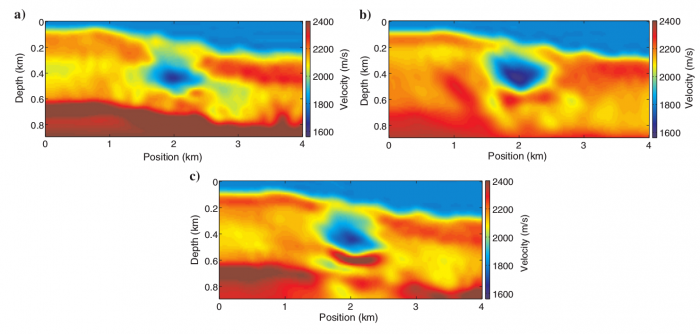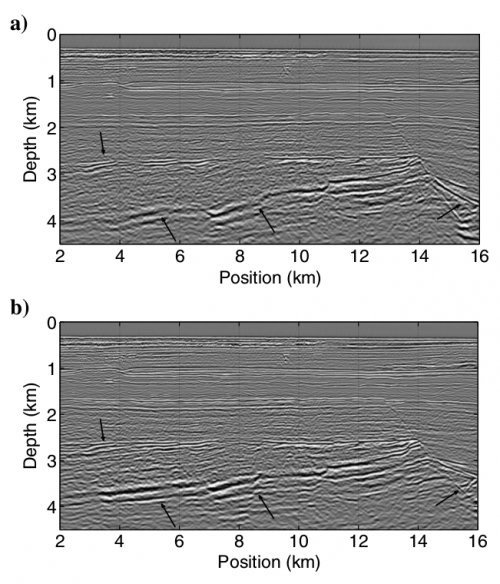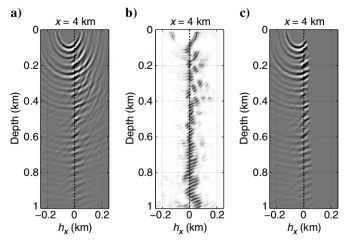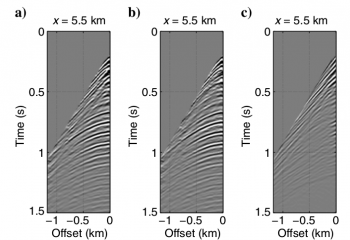Research
Automatic velocity analysis with reverse-time migration
We apply a wave equation migration velocity analysis method to automatically estimate the background velocities using reverse-time migration. The method uses a combination of differential semblance and similarity-index (a.k.a., “semblance” or “stacking-power”) to measure the focusing error in imaging and a nonlinear optimization procedure to obtain the background velocities. A challenge in this procedure is that, for media consisting of complex and strongly refracting velocities, artifacts in the reverse-time migrated image (low-frequency noise) can cause the velocity analysis to diverge. We successfully overcome this issue by applying a simple vertical derivative filter to the image that is input to velocity analysis.
Anisotropic migration velocity analysis using reverse-time migration
In this paper, we extend wave equation migration velocity analysis to deal with a 2D TTI model of the subsurface and test it on synthetic and field surface seismic data. To account for anisotropy in the kinematics of wave propagation, we use a density-normalized elastic wave equation that is stable and accurately propagates waves at all angles, which is important for the estimation of anisotropic parameters. We use WEMVA to simultaneously estimate VP0 , ε, and δ. The parameter V S0 is assumed to have a negligible influence on P-wave propagation and is chosen arbitrarily. In addition, θ is assumed to conform to the geology and is estimated from the structure of the reflectors in the migrated image.
Reverse-time demigration using the extended-imaging condition
Most classical seismic data processing methods in the data domain are based on simplified assumptions about the subsurface structure, such as horizontal layering and mild lateral variations in mechanical properties. Over such media, reflection data can be described by simple equations such as hyperbolas. However, complex geologic media will cause complicated waveforms as seismic waves propagate through them. As the medium deviates from the simple models, the complexity of the reflection data increases and the classical seismic data processing methods start to fail. This calls for special treatment of complex data, which substantially complicates seismic data processing. On the other hand, the image domain allows unified treatment of data acquired over simple and complex media because the effects of the medium on the kinematics of wave propagation are largely removed by the process of backpropagation, which is inherent to the migration procedure. This characteristic makes the image domain a powerful alternative to the data domain for seismic data processing. A challenge in designing seismic data processing methods in the image domain is the need for an accurate estimate of the migration velocities. In this work, we show how we can relax this requirement. We also show how we can, through demigration, transform the results of seismic data processing in the image domain back to the data domain
<center />
</center>
Time-lapse full-waveform inversion of limited-offset seismic data using a local migration regularization
Conventional methods for quantifying time-lapse seismic effects rely on a linear assumption that is easily violated. Therefore, more sophisticated methods are necessary. The full-waveform inversion (FWI) method is an inverse method that is able to reveal time-lapse changes in the image domain, in which the conventional methods break down. We investigated the behavior of FWI using different approaches for applying FWI on limited-offset time-lapse data. We compared acoustic and elastic inversion schemes. We introduced a method for constraining the model update for the monitor model to remove time-lapse artifacts. This method was based on migration of the residuals in the time-lapse data, which, in combination with a local contrast estimation algorithm, formed the update constraint. We found that for limited-offset data, elastic theory was necessary for the success of FWI and that FWI was able to quantify the time-lapse changes in the parameter models. The local migration regularization approach was able to remove time-lapse artifacts.
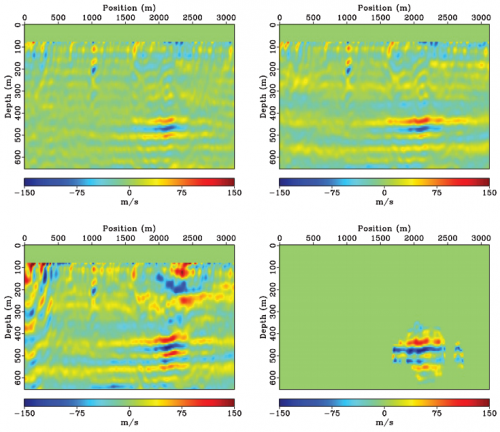
Shot-profile true amplitude cross-correlation imaging condition
The U/D imaging condition for shot profile migration can be used to
estimate the angle dependent reflection coefficient, but is difficult to
implement numerically because of the spectral division involved. Most techniques for
stabilizing the division require a damping factor which might be difficult to estimate and
which also introduces bias into the final result.
A stable result can be achieved by approximating the imaging condition with a cross-correlation of the
up- and downgoing wavefields at
zero time lag, but this will lead to incorrect Amplitude-Versus-Angle (AVA) behavior of the estimated
reflection coefficient.
We use a simple model for wave propagation of primary reflections in the
wavenumber frequency domain
and invert the model with respect to the reflection coefficient. By using the properties of
wavefield extrapolators it can then be shown that the reflection coefficients can be estimated
by cross-correlation of the upgoing wavefield and a downgoing wavefield where the initial wavefield is the inverse of the wavefield generated by a point source.
The new imaging condition gives the correct angle-versus-amplitude
behavior for horizontal reflectors as shown on the figure below. For dipping
reflectors it is shown that a post-migration correction factor can be used to recover the correct angle behavior of
the reflection coefficient.
The new imaging condition is numerically stable, does not involve damping factors, is simple to implement numerically and is a simple modification of
the classical cross-correlation imaging condition. Numerical examples confirm the correct AVA behavior of the new imaging condition.
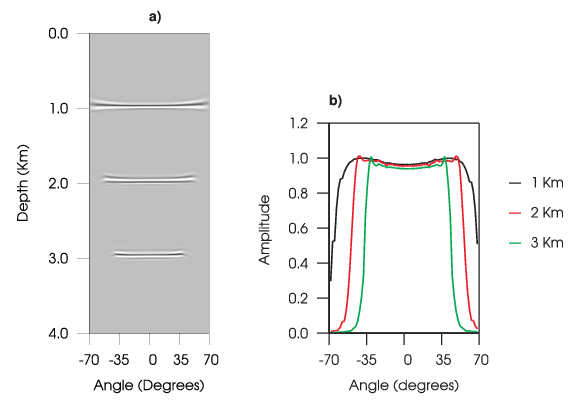
Read more: pdf

